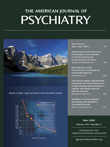Neuroticism and Affective Instability: The Same or Different?
Abstract
Objective: The purpose of this study was to examine the correlates and consequences of two constructs related to affective experience: neuroticism and affective instability. Method: One hundred thirty-two patients were assessed at intake for axis I and II symptoms, general personality traits, and specific impairments, including impairments in interpersonal functioning. The data included responses to structured and semistructured interviews, self-reports of interpersonal problems, and reports of interpersonal problems from significant others. Clinical ratings of axis I and II symptoms and of impairment were made by using the LEAD (i.e., longitudinal, expert, all data) consensus approach. Ninety-one of the 132 patients were reassessed at 12-month follow-up. Results: Neuroticism and affective instability manifested varied concurrent relations, with neuroticism being strongly related to an anxious, avoidant style and affective instability related to more externalizing personality styles. Prospectively, neuroticism predicted later symptoms, occupational impairment, and global dysfunction, whereas affective instability predicted romantic impairment. Conclusions: The findings suggest that neuroticism and affective instability—which are considered core aspects of personality pathology—are related but distinct constructs with unique correlates and different predictive abilities.



